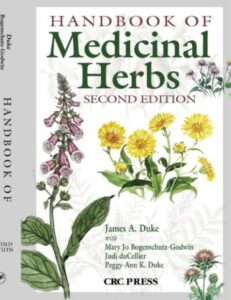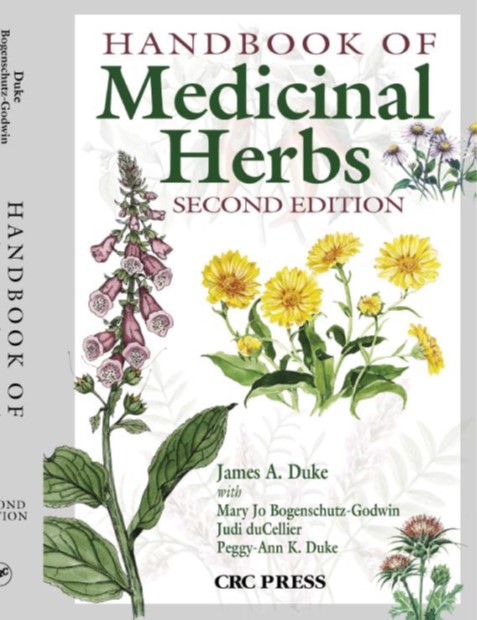Hand Book of Medicinal Herbs

Hand Book of Medicinal Herbs – By the time this second edition is published, the first edition of the Handbook of Medicinal Herbs will have been out more than 15 years.
The second edition is designed to present most of the old information plus new information on the more important of those original 365 herbs. I submitted the first edition under the original unpublished title, Herbs of Dubious Salubrity.
I intentionally left out many of the completely safe culinary herbs, spices, and food plants that are clearly medicinal. I also intentionally omitted some strictly dangerous herbs, such as foxglove, that were too unhealthy for use in unskilled hands.
I did include several obscure hallucinogenic plants of dubious Selebrity. I did, or should have, dropped some of these because they have little medicinal importance. Some poorly documented species, such as Mimosa hostilis and Phoradendron leucarpum , for example, were retained with fragmentary entries, so as to at least mention species from the first edition that might better have been dropped.
Now I think I have the most important herbs well covered here. In edition two, which I will refer to frequently as my Herbal Desk Reference (HDR), I have tried to concisely corral the data on some 1000 herbs in as little space as possible, striving to make a reliable, referenced resource to parallel the PDR for Herbal Medicines.
I use the three-letter abbreviation, HDR, to indicate the second edition of my Handbook of Medicinal Herbs, because I compare and contrast it to other important sources, which are also represented by three-letter abbreviations. (See the reference abbreviation appendix.)
With this edition, I have tried to cover most of the widely mentioned medicinal plants, whether they are extremely salubrious or extremely toxic. Without counting them, I estimate we include more than 1000 of the most important herbs, including the more important herbs from the young Native American and the European traditions (including most of those approved by Commission E (KOM), and almost all of those included in the PDR for Herbal Medicine (PHR for the first edition, and PH2 for the second edition).
Unlike Commission E and the Herbal PDR, which seem to stress European and American traditions, I include proportionately more herbs from the older African, Ayurvedic, and Chinese traditions as well, not wanting to slight any major medicinal plant from any major tradition.
Let’s Get Started
ABSCESS ROOT (Polemonium reptans L.) +
Activities (Abscess Root) — Alterative (f; EFS); Antipyretic (f; EFS); Astringent (1; PH2);
Diaphoretic (1; EFS; PH2); Expectorant (1; EFS; PH2).
Indications (Abscess Root) — Fever (f; EFS; PH2); Inflammation (f; PH2).
Dosages (Abscess Root) — No real dosage given (PH2).
Contraindications, Interactions, and Side Effects (Abscess Root) — Not covered (AHP; KOM).
ACACIA, BABUL (Acacia nilotica (L.) Willd. ex Delile) ++
Synonym — Acacia arabica (Lam.) Willd.
Activities (Acacia) — Alexeteric (f; KAB); Algicide (1; ZUL); Amebicide (1; ZUL); Antibacterial
(1; ZUL); Antiedemic (1; ABS); Antihistaminic (1; ZUL); Antiinflammatory (f; ABS); Antitussive
(f; BIB); Aphrodisiac (f; MPI; ZUL); Astringent (f; GMH; PH2); Decongestant (f; BIB); Demulcent
(f; BIB; DEP); Expectorant (f; KAB; MPI); Hemostat (f; DEP); Hepatotonic (f; KAB); Hypoglycemic
(1; ZUL); Hypotensive (1; ZUL); Lactagogue (f; BIB; UPW); Molluscicide (1; ZUL);
Neurostimulant (f; BIB); Protisticide (1; ZUL); Stimulant (f; BIB); Taenicide (1; ZUL); Teratologic
(f; ZUL); Tonic (f; DEP); Vermifuge (1; KAB; ZUL).
Indications (Acacia) — Ameba (1; ZUL); Ascites (f; KAB); Bacteria (1; ZUL); Biliousness (f; KAB);
Bleeding (f; BIB; DEP); Bronchosis (f; KAB); Burn (f; SKJ); Cancer (f; BIB); Cancer, ear (f; JLH);
Cancer, eye (f; JLH); Cancer, liver (f; JLH); Cancer, spleen (f; JLH); Cancer, testes (f; JLH); Catarrh
(f; HH2); Childbirth (f; DEP); Chill (f; ZUL); Cholecystosis (f; BIB); Cholera (f; SKJ); Colic (f; KAB);
Condyloma (f; BIB); Congestion (f; BIB); Conjunctivosis (f; DEP); Cough (f; DEP; KAB); Cystosis
(f; DEP); Diabetes (1; DEP; ZUL); Diarrhea (f; GMH; PH2); Dysentery (f; BIB; DEP); Dyspepsia (f;
ZUL); Dysuria (f; KAB); Enterosis (f; DEP); Fever (f; BIB; UPW); Flu (1; ABS); Fracture (f; KAB);
Gastrosis (f; DEP); Gingivosis (f; DEP; PH2); Gonorrhea (1; DEP; ZUL); Hemorrhoid (f; BIB; KAB;
PH2); Hepatosis (f; BIB); High Blood Pressure (1; ZUL); Hyperglycemia (1; ZUL); Hypersalivation
(f; DEP); Induration (f; BIB; JLH); Infection (1; ZUL); Inflammation (1; ABS; PH2); Insanity (f;
KAB); Leprosy (f; KAB); Leukoderma (f; KAB); Leukorrhea (f; DEP); Menorrhagia (f; DEP); Mucososis
(f; PH2); Odontosis (f; PNC); Ophthalmia (f; BIB; JLH); Orchosis (f; BIB); Otosis (f; BIB; JLH);
Pharyngosis (f; PH2); Pneumonia (f; ZUL); Proctosis (f; DEP; UPW); Puerperium (f; DEP); Pulmonosis
(f; ZUL); Sclerosis (f; BIB); Smallpox (f; BIB); Snakebite (f; DEP); Sore (f; DEP; UPW); Sore
Throat (f; DEP); Splenosis (f; JLH); Staphylococcus (f; ZUL); Stomachache (f; UPW); Stomatosis (f;
DEP; PH2; UPW); Strangury (f; KAB); Swelling (1; ABS); Syphilis (f; BIB); Tapeworm (1; ZUL);
Toothache (f; ZUL); Tuberculosis (f; BIB); Typhoid (f; BIB); Urethrosis (f; KAB); Uterosis (f; DEP;
KAB); Vaginosis (f; KAB; PH2); VD (f; DEP); Worm (1; KAB; ZUL); Wound (f; UPW).
Contraindications, Interactions, and Side Effects (Acacia) — None covered (AHP; KOM). Large internal doses may lead to constipation and dyspepsia (PH2).
ADAM’S NEEDLES, SPANISH BAYONET (Yucca filamentosa L.) ++
Few taxonomists and herbalists and even fewer pharmacists and physicians can distinguish the Yucca species in the field. How then can they distinguish them ground and powdered in the capsule?
APA covers also Yucca brevifolia, Y. glauca, and Y. schidigera.
Activities (Adam’s Needles) — Antiarthritic (1; APA); Antiherpetic (1; APA); Antiinflammatory
(f; WOI); Antimelanomic (1; APA); Antitumor (1; APA); Antiviral (1; APA); Hemolytic (1; APA);
Piscicide (2; DEM; FAD); Sedative (f; DEM).
Indications (Adam’s Needles) — Adenopathy (f; WOI); Arthrosis (1; APA); Biliousness (f; WOI);
Bleeding (f; APA); Cholecystosis (f; PHR; PH2); Cytomegalovirus (1; APA); Depression (f; WOI);
Dermatosis (f; APA; DEM; FAD); Diabetes (f; DEM); Gonorrhea (f; WOI); Headache (1; APA;
WOI); Hepatosis (f; PHR; PH2); Herpes (1; APA); High Blood Pressure (1; APA); High Cholesterol
(1; APA); Inflammation (f; APA; WOI); Insomnia (f; DEM); Melanoma (1; APA); Migraine (f;
APA); Nervousness (f; DEM); Pain (1; APA); Rheumatism (1; APA; WOI); Sore (f; APA; DEM;
FAD); Sprain (f; DEM; FAD); Stomatosis (f; WOI); Swelling (1; APA); Tumor (1; APA); VD (f;
WOI); Virus (1; APA).
Dosages (Adam’s Needles) — 3 (490 mg) capsules 3 ×/day (APA).
Contraindications, Interactions, and Side Effects (Adam’s Needles) — AHP classifies four other Yuccas as Class 1. “Hazards and/or side effects not known for proper therapeutic dosages” (PH2).
(but PH2 designates no specific quantified dosage! JAD). Root compounds toxic to lower life forms (FAD). Saponins can cause gastric discomfort (PHR).
AFRICAN CAPER (Capparis tomentosa Lam.) +
Activities (African Caper) — Antispasmodic (1; VVG); Decongestant (f; ZUL); Depurative (f; ZUL); Diuretic (f; ZUL); Emetic (f; ZUL); Expectorant (f; ZUL); Philtre (f; ZUL); Tonic
(f; ZUL).
Indications (African Caper) — Chest Ache (f; VVG; ZUL); Cough (f; VVG; ZUL); Cramp (1; VVG); Diarrhea (f; ZUL); Fever (f; ZUL); Gastrosis (f; ZUL); Gonorrhea (f; ZUL); Headache (f; VVG; ZUL); Impotence (f; ZUL); Infertility (f; ZUL); Insanity (f; VVG; ZUL); Jaundice (f; VVG; ZUL); Leprosy (f; ZUL); Malaria (f; VVG; ZUL); Mastosis (f; ZUL); Miscarriage (f; ZUL); Ophthalmia (f; ZUL); Pleurisy (f; ZUL); Pneumonia (f; VVG); Rheumatism (f; VVG); Scrofula (f; ZUL); Snakebite (f; VVG; ZUL); Swelling (f; ZUL); Water Retention (f; ZUL); Wound (f; ZUL).
Contraindications, Interactions, and Side Effects (African Caper) — In view of reported poisonings, indiscriminate use is discouraged (VVG); human fatalities reported following root ingestion. Contains stachydrine (ZUL).
AFRICAN SPURGE (Euphorbia resinifera O. Berg & C. F. Schmidt) X
Activities (African Spurge) — Abortifacient (f; PH2); Carcinogenic (1; PH2); Emetic (1; PH2); Immunostimulant (1; PH2); Irritant (1; PH2); Laxative (1; EFS; PH2); Rubefacient (f; EFS); Sialagogue (f; PH2); Toxic (f; EFS); Vesicant (f; EFS).
Indications (African Spurge) — Bronchosis (f; HHB); Cancer (f; JLH; PH2); Catarrh (f; HHB); Conjunctivosis (f; HHB; PH2); Constipation (f; PH2); Dermatosis (f; PH2); Diarrhea (f; HHB); Dropsy (f; PH2); Dysmenorrhea (f; PH2); Epistaxis (f; HHB); Gout (f; PH2); Headache (f; PH2); Immunodepression (1; PH2); Infection (f; PH2); Inflammation (f; PH2); Otosis (f; PH2); Plantar Wart (f; JLH); Respirosis (f; PH2); Sore (f; PH2); Ulcer (f; PH2); Wart (f; PH2).
Dosages (African Spurge) — Don’t take it (JAD).
Contraindications, Interactions, and Side Effects (African Spurge) — Not covered (AHP). Topically very irritating. Ingestion can cause death, burning gastrosis, colic, diarrhea, nephrosis, salivation (PH2).
Read Loads More Inside…
893 Pages Grab Your Copy Now $57

Just Click on the Purchase Button Below to Get Instant Access.
Warmest Regards,
Coyalita Linville
Copyright © 2023 Sunrise-Sunset-Nature-Gardens.com. All Rights Reserved Privacy Policy – Earning Disclaimer – Terms of Use – Contact Us

